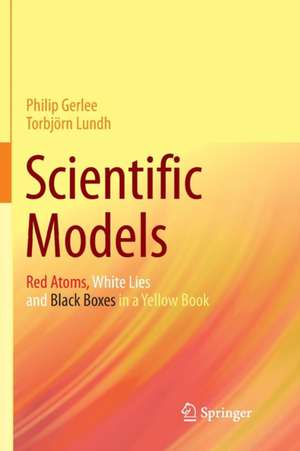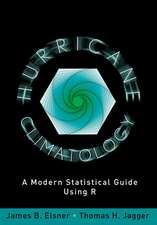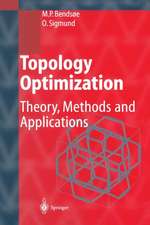Scientific Models: Red Atoms, White Lies and Black Boxes in a Yellow Book
Autor Philip Gerlee, Torbjörn Lundhen Limba Engleză Paperback – 31 mai 2018
The book is aimed primarily at students in the sciences and engineering, as well as students at teacher training colleges but will also appeal to interested readers wanting to get an overview of scientific modelling in general and different modelling approaches in particular.
| Toate formatele și edițiile | Preț | Express |
|---|---|---|
| Paperback (1) | 378.95 lei 6-8 săpt. | |
| Springer International Publishing – 31 mai 2018 | 378.95 lei 6-8 săpt. | |
| Hardback (1) | 323.28 lei 6-8 săpt. | |
| Springer International Publishing – 18 iul 2016 | 323.28 lei 6-8 săpt. |
Preț: 378.95 lei
Nou
Puncte Express: 568
Preț estimativ în valută:
72.52€ • 74.92$ • 60.36£
72.52€ • 74.92$ • 60.36£
Carte tipărită la comandă
Livrare economică 25 martie-08 aprilie
Preluare comenzi: 021 569.72.76
Specificații
ISBN-13: 9783319800684
ISBN-10: 331980068X
Ilustrații: X, 96 p. 28 illus., 8 illus. in color.
Dimensiuni: 155 x 235 mm
Greutate: 1.77 kg
Ediția:Softcover reprint of the original 1st ed. 2016
Editura: Springer International Publishing
Colecția Springer
Locul publicării:Cham, Switzerland
ISBN-10: 331980068X
Ilustrații: X, 96 p. 28 illus., 8 illus. in color.
Dimensiuni: 155 x 235 mm
Greutate: 1.77 kg
Ediția:Softcover reprint of the original 1st ed. 2016
Editura: Springer International Publishing
Colecția Springer
Locul publicării:Cham, Switzerland
Cuprins
Prologue.- History.- Structure, Relation and Use.- Interviews.- Worked Examples.- Epilogue.- Further Reading.
Recenzii
“The authors look at the modelling of phenomena in different fields such as physics, chemistry, statistics, engineering and zoology. … The various illustrations contribute to illuminate the different concepts and topics. The book is quite entertaining, enjoyable to read and can be recommended for scientists and students alike from different fields.” (Willi-Hans Steeb, zbMATH 1354.00064, 2017)
Notă biografică
Philip Gerlee is a researcher in biomathematics and works on problems in cancer research, evolutionary dynamics and ecology. He earned his undergraduate degree in Physics and went on to pursue a Master’s degree in Complex and Adaptive systems at Chalmers University of Technology. His PhD was earned at University of Dundee for theoretical research into the evolutionary dynamics of solid tumour growth. After completing his doctoral work he worked as a postdoc at the Niels Bohr Institute, University of Gothenburg and the Moffitt Cancer Center in Tampa. He is currently working as assistant professor in the Department of Mathematical Sciences at Chalmers and University of Gothenburg.
After obtaining a masters in technology and a PhD in pure mathematics in Uppsala, Sweden, Torbjörn Lundh got three Postdoctoral Fellowships at: Cambridge University, Stony Brook University and Institute Mittag-Leffler. During these postdocs he got increasingly interested in biological applications,especially morphogenesis, speciation and artificial ecology. He has then been pursuing this interest at the department of Mathematical Sciences in Chalmers and University of Gothenburg. He recently became the vice president of the European Society for Mathematical and Theoretical Biology and is currently on a sabbatical working on stent related interdisciplinary questions in vascular surgery at Stanford Hospital.
After obtaining a masters in technology and a PhD in pure mathematics in Uppsala, Sweden, Torbjörn Lundh got three Postdoctoral Fellowships at: Cambridge University, Stony Brook University and Institute Mittag-Leffler. During these postdocs he got increasingly interested in biological applications,especially morphogenesis, speciation and artificial ecology. He has then been pursuing this interest at the department of Mathematical Sciences in Chalmers and University of Gothenburg. He recently became the vice president of the European Society for Mathematical and Theoretical Biology and is currently on a sabbatical working on stent related interdisciplinary questions in vascular surgery at Stanford Hospital.
Textul de pe ultima copertă
A zebrafish, the hull of a miniature ship, a mathematical equation and a food chain - what do these things have in common? They are examples of models used by scientists to isolate and study particular aspects of the world around us. This book begins by introducing the concept of a scientific model from an intuitive perspective, drawing parallels to mental models and artistic representations. It then recounts the history of modelling from the 16th century up until the present day. The iterative process of model building is described and discussed in the context of complex models with high predictive accuracy versus simpler models that provide more of a conceptual understanding. To illustrate the diversity of opinions within the scientific community, we also present the results of an interview study, in which ten scientists from different disciplines describe their views on modelling and how models feature in their work. Lastly, it includes a number of worked examples that span different modelling approaches and techniques. It provides a comprehensive introduction to scientific models and shows how models are constructed and used in modern science. It also addresses the approach to, and the culture surrounding modelling in different scientific disciplines. It serves as an inspiration for model building and also facilitates interdisciplinary collaborations by showing how models are used in different scientific fields.
The book is aimed primarily at students in the sciences and engineering, as well as students at teacher training colleges but will also appeal to interested readers wanting to get an overview of scientific modelling in general and different modelling approaches in particular.
Caracteristici
Provides a comprehensive introduction to scientific models Recounts the history of modelling Serves as an inspiration for model building Includes supplementary material: sn.pub/extras














